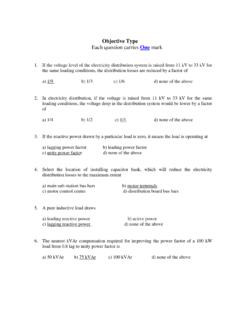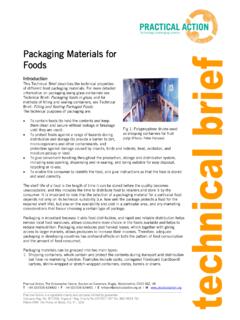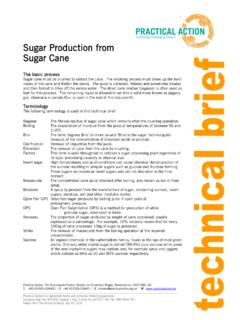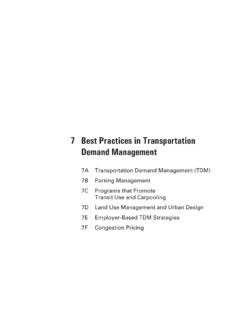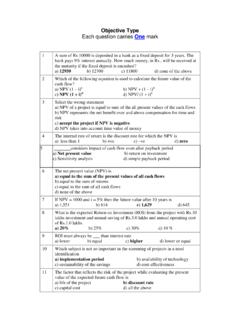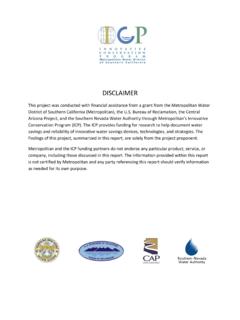Transcription of Public water conservation campaigns - ctc-n.org
1 Climate Change Adaptation Technologies for water A practitioner s guide to adaptation technologies for increased water sector resilience water ADAPTATION TECHNOLOGY BRIEF Download full publication from: Public water conservation campaigns Challenge: Too little water Adaptation response: water efficiency and demand management Description Public water conservation campaigns raise awareness in all levels of society about the importance of saving water to cope with its scarcity and ensure sustainability. The aim is to change citizen attitudes and behaviour to improve water use efficiency. This is done through education and awareness campaigns on the socioeconomic and environmental benefits of water conservation and different conservation methods. Communication means include traditional and social media, as well as direct communication such as workshops, presentations, stakeholder dialogues, etc. Other means such as economic incentives can also be employed, for example, free installation of water meters.
2 Raising water conservation awareness is important as the combined impact of even small improvements in individual household use can amount to significant savings at a municipality or regional level. Implementation Preparation and execution of Public awareness campaigns requires a multidisciplinary team, including water experts, building and construction experts, and social marketing, communication and outreach and education professionals. A thorough analysis of local Public water systems and consumer habits is typically undertaken (often using household surveys) to identify potential water savings and primary targets for consumer behaviour patterns. This includes identification of main target groups for awareness campaigns , for example local water utility companies, households, workplaces, large businesses, etc. campaigns can also establish water conservation goals to facilitate tracking of progress and achievement of objectives.
3 Critical components of planning and executing a campaign include communication protocols and materials organization and production, and establishment of partnerships with media, schools, local NGOs, etc. for effective dissemination. Environmental Benefits - Reduces end water -use, in turn reducing pressures on water utilities, local freshwater sources and the environment. - Requires less energy for abstraction, transport and treatment, mitigating greenhouse gas emissions. Socioeconomic Benefits - Reduces water costs for utilities and end users. Opportunities and Barriers Opportunities: - Better understanding of water conservation is likely to promote greater sustainable behaviour amongst citizens - Inclusive approach encourages stakeholders and organizations to engage and work together - Results in climate resilience: adaptation and mitigation benefits, such as water source protection, water use reduction and mitigation of greenhouse gasses - Relatively low cost-technology with wide reach Climate Change Adaptation Technologies for water A practitioner s guide to adaptation technologies for increased water sector resilience water ADAPTATION TECHNOLOGY BRIEF Download full publication from: Barriers.
4 - Certain conservation techniques such as water recycling need associated education on correct use to ensure safety and minimizing health threats from potential contamination - Success can be impeded due to Public scepticism and lack of understanding about the impacts of personal water -use on overall supplies - Success often relies on individual behaviour on private properties, which can be difficult to monitor and measure, revealing only changes in combined impacts Implementation considerations* Technological maturity: 4-5 Initial investment: 2-3 Operational costs: 1-3 Implementation timeframe: 3-4 * This adaptation technology brief includes a general assessment of four dimensions relating to implementation of the technology. It represents an indicative assessment scale of 1-5 as follows: Technological maturity: 1 - in early stages of research and development, to 5 fully mature and widely used Initial investment: 1 very low cost, to 5 very high cost investment needed to implement technology Operational costs: 1 very low/no cost, to 5 very high costs of operation and maintenance Implementation timeframe: 1 very quick to implement and reach desired capacity, to 5 significant time investments needed to establish and/or reach full capacity This assessment is to be used as an indication only and is to be seen as relative to the other technologies included in this guide.
5 More specific costs and timelines are to be identified as relevant for the specific technology and geography. Climate Change Adaptation Technologies for water A practitioner s guide to adaptation technologies for increased water sector resilience water ADAPTATION TECHNOLOGY BRIEF Download full publication from: Sources and further information EPA (2015). California water Action Plan and Save Our water Program Public Education campaigns . US Environmental Protection Agency. Available at: Howarth, D. and Butler, S. (2003). Communicating water conservation : How can the Public be engaged? National water Demand Management Centre, Environment Agency of England and Wales. March, H., Hern ndez, M. and Saur , D. (2015). Assessing domestic water use habits for more effective water awareness campaigns during drought periods: a case study in Alicante, eastern Spain. Natural Hazards and Earth System Sciences, 15, pp.
6 963 972. Available at: UNEP ( ). water conservation : A Guide to Promoting Public Awareness. United Nations Environmental Programme. Available at: Tearfund (2007). Sanitation and hygiene in developing countries: identifying and responding to barriers, A case study from Madagascar. Tearfund. Available at: Texas water Development Board (2010). Developing a water conservation Public Awareness Program: A Guide for Utilities. water IQ. Available at: water Use It Wisely (2016). The Tools of the water -Wise Trade. Park and co. Available at.
